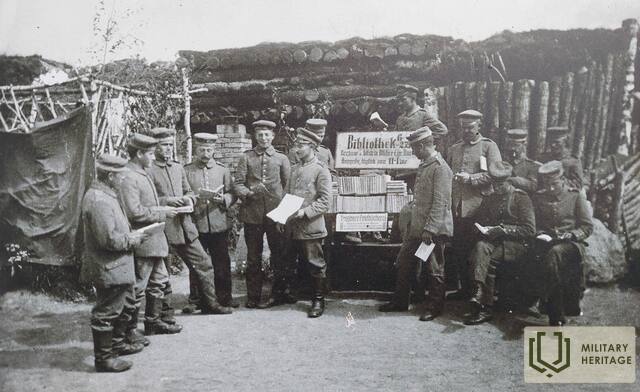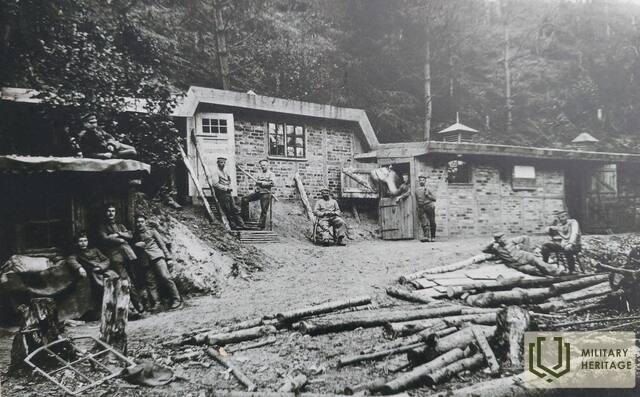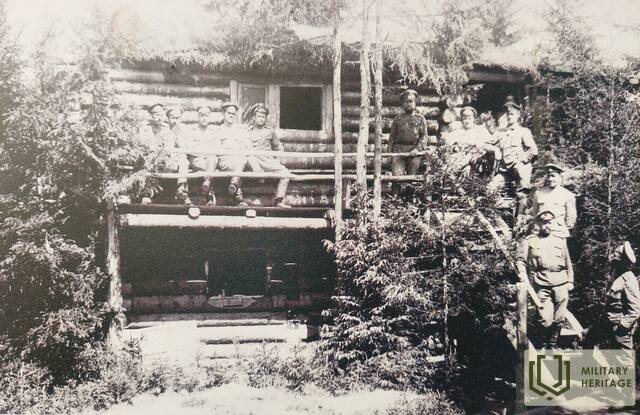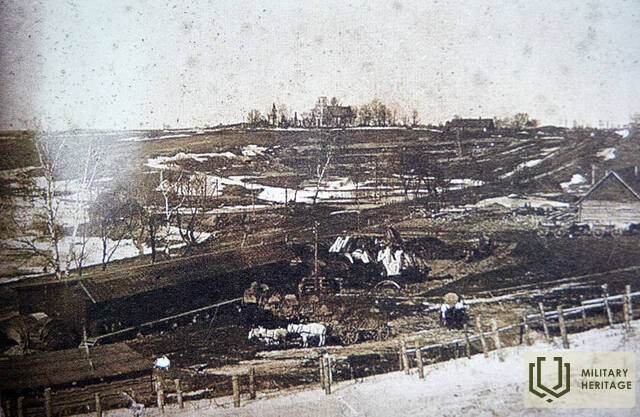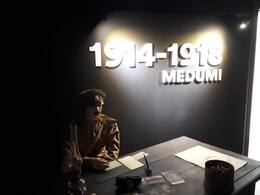Apie požeminį miestą Egipte ir Sodiškes
1915 m., kai vokiečių kariuomenė įžengė į Latvijos teritoriją, pirmasis karo etapas pasižymėjo manevriniu karu. 1915 m. rudenį, frontui stabilizavusis ties natūralia Dauguvos kliūtimi, prasidėjo pozicijų karas, trukęs dvejus metus – iki 1917 m. rudens, kai vokiečių armija, pasinaudodama revoliuciniais pokyčiais Rusijos imperijoje ir Rusijos armijos demoralizacija bei žlugimu, perėjo į puolimą.
Bet kuris nepuolantis karių vienetas pradeda įsitvirtinti ir įtvirtintis. Tai diktuoja tiek karinė doktrina, tiek taktiniai sumetimai, tiek poreikis išgyventi. Apkasai ir pozicijos apsaugo kareivius nuo tiesioginės ir netiesioginės priešo ugnies (artilerijos), taip pat nuo nepalankių oro sąlygų.
Iš pradžių pozicijos buvo statomos iš medinių rąstų, vėliau – 1916 m. pradžioje – betoninės pozicijos. Vokietijos armijoje daliniai tarp fronto sektorių buvo keičiami rečiau, todėl vokiečių kareiviai į pozicijų statybą žiūrėjo atsargiau – jie žinojo, kad stato pozicijas sau ir kad jose taip pat turės gyventi. Rusijos armijoje daliniai buvo reguliariai perkeliami tarp sektorių, be to, Rusijos pusėje betoninės pozicijos nebuvo statomos.
Pirmoji Rusijos armijos linija ėjo per Medumį. Pirmoji vokiečių gynybos linija buvo už 400 metrų, kitame Medumio ežero krante. Toliau į pietus, Sodiškėse (dabar maždaug Upmalių vietoje), buvo artilerijos pulko štabas. Šalia štabo buvo stebėjimo bunkeris. Sodiškėse buvo visa eilė bunkerių, tačiau jie buvo mediniai, todėl neišliko. Vietovėje matomos tik jų vietos.
Egipte arba Vilkumiestoje, kuri buvo įsikūrusi antroje vokiečių linijoje, buvo įkurtas požeminis miestas. Nuo 1836 m. Vilkumiestoje veikė paštas. 1915 m. Vilkumiestą sugriovė besitraukianti Rusijos armija, kad vokiečiai neturėtų kur gyventi. Su Vilkumiesta susiję dar du įdomūs istoriniai faktai – čia nuo 1873 iki 1874 m. Oskaro Svensono pensione mokėsi Janis Rainis. Mokyklą įkūrė baronas Oettingenas, rūpinęsis parapijos plėtra. Pasakojama, kad jo draugas, būsimasis Vokietijos kancleris Otas fon Bismarkas, lankėsi Oettingene ir 10 dienų praleido Vilkumiestoje. Vėliau Oettingenas iš jam priklausančios Kalkūnų spirito varyklos taip pat atsiųsdavo Bismarckui stipriųjų gėrimų. Nors tokie epizodai Bismarcko biografijoje neaprašyti, istorija yra gana tikėtina, atsižvelgiant į glaudžius Bismarcko ryšius su Baltijos didikais ir į tai, kad Bismarckas buvo Prūsijos ambasadorius Rusijos imperijoje nuo 1859 iki 1862 m., dirbo Sankt Peterburge. Vilkumiest miestas buvo įsikūręs prie Sankt Peterburgo–Varšuvos maršruto, kuris buvo greičiausias kelias į Vokietiją.
Apie užnugario pozicijų statybą galima paskaityti pionieriaus leitenanto Hanso Tröbsto, tarnavusio 77-osios rezervinės divizijos 147-ojo pėstininkų pulko 78-ojoje rezervinėje pionierių kuopoje, atsiminimuose. Ši kuopa buvo vienintelė visoje divizijoje, todėl į darbą plačiai įsitraukė ir patys pėstininkų daliniai, taip pat 42-asis kalinių batalionas, kuris, remdamasis tarptautiniais susitarimais, greitai atsisakė dirbti Rusijos armijos artilerijos pasiekiamumo zonoje. Iš H. Trobsto memuarų: „Bataliono vadas nusprendė įkurti stovyklą kaip ilgą, vienpusę „gatvę“ pasirinktame šlaite. Kadangi buveinės taip pat turi turėti galimybę apsiginti, jis taip pat nusprendžia, kur reikės kasti apkasus. Kiekviena kuopa gavo savo stotį ir darbas prasidėjo! Tačiau lengva pasakyti ir klausytis. Bet kokie sunkumai perskelti žemę, pilną šaknų, šiais „arbatos kastuvais“ – pėstininkų sapierių kastuvais. Šaknys ir kelmai buvo šalinami durtuvais, kišeniniais peiliais, kastuvais ir kirviais. Iš tolimojo užnugario į kiekvieną kuopą kaip skruzdėlės buvo tempiami vežimai su statybinėmis medžiagomis. Kiekvienas medžio gabalas pasirodė esąs naudingas. Kuopai labai pasisekė, jei pavykdavo rasti beržų giraitę. Kad ir koks didelis būtų toks miškas – jis išnyko po 2–3 dienų. Sunku buvo įsivaizduoti tinkamesnę statybinę medžiagą nei beržas. Juos buvo lengva transportuoti, jie buvo paklusnūs kaip ėriukas – iš jų buvo galima daug ką pagaminti ir tai buvo daroma. Iš beržo buvo gaminami kryžiai kapinėms, stulpai užtvankoms,“ grotelės tranšėjoms, telefono stulpai, gyvenamųjų erdvių dekoracijos, tiltų turėklai, kėdės ir lovos. Papuošalai dirbo kaip bitės, ruošdami pastoges ateinantiems 6 mėnesiams arba bent iki pavasario.“
Kai tik įmanoma, kareiviai, ypač karininkai, gyvendavo apleistuose vietos gyventojų namuose antrose linijose ir artilerijos pozicijose. H. Trobsto memuaruose aprašomos tokios gyvenimo sąlygos: „Baldai buvo gana geri – ūkininkas, ankstesnis baldų savininkas, akivaizdžiai gyveno gana gerai. Kambaryje buvo didelis sieninis veidrodis, siuvimo mašina ir europietiško stiliaus spintelės, kėdės bei stalai. Sienos buvo išklijuotos tapetais, papuoštos paveikslais ir džiovintomis gėlėmis. Kambarys buvo padalintas sienomis iki pat lubų, o visur buvo įrengtos tinkamos durys. Svetainės centre, tarp dviejų durų, buvo didelis atviras židinys, kurį pats pasistačiau, jis buvo pritaikytas kūrenti ąžuolo malkomis. Puikios ąžuolo malkos, kurios buvo sukrautos namo gale, davė mums puikų kurą.“
Kadangi divizijoje nebuvo pakankamai pionierių, o pėstininkai taip pat atliko statybos darbus, pirmasis leitenantas Trobstas parengė metodinę medžiagą betonavimo darbams atlikti „Betono vadovą (Anleitung zum Betonieren)“, o kiekviena kuopa gavo aprašymą su brėžiniais.
Kadangi fronto linijose nebuvo įmanoma išlieti betoninių bunkerių, buvo nuspręsta gaminti betonines plokštes, tiksliau, blokus, iš kurių vėliau būtų galima statyti pastatus. Šiuo tikslu Staro Dvoriščėje buvo įkurta betoninių plokščių gamykla. Blokai turėjo būti tokio svorio, kad juos galėtų pakelti vienas ar du kareiviai – 15 centimetrų storio ir 60×60 centimetrų dydžio. Į jų vidų buvo įdėti ploni geležiniai strypai kaip armatūros tvirtinimo detalės. Tada forma buvo užpildyta cemento ir smėlio mišiniu. Plokštės sujungė taip tiksliai, kad jomis buvo galima iškloti gatves. Pionieriai taip didžiavosi savo gaminiu, kad ant kiekvienos plokštės palikdavo ženklą: „R. Pi.K. 78“, kas išvertus reiškia „Rezervinis pionierius-kompanija 78“.
Susijusios vietos
790 dviračių maršrutas „Per Pirmojo pasaulinio karo bunkerius“
Pažymėtas tarpvalstybinis maršrutas, einantis per Latvijos ir Lietuvos teritoriją.
Pirmojo pasaulinio karo metu Latvijos ir Lietuvos teritorijoje keletą metų driekėsi „Gyvybės ir mirties“ fronto linija. Abiejose jos pusėse buvo pastatyta sudėtinga įtvirtinimų sistema su apkasais, bunkeriais ir bunkeriais. Tūkstančiai kareivių čia kovojo ir žuvo įnirtingose kovose, ką liudija nesuskaičiuojami žuvusių kareivių palaidojimai.
Pirmasis pasaulinis karas paliko ilgalaikius randus ne tik žmonių likimuose ir širdyse, bet ir mūsų žemėje. Iki šiol Medumi parapijos, Augšdaugavos krašto, miškuose išliko nesuskaičiuojama daugybė vokiečių įrengtų betoninių bunkerių, ginklų ir šaudmenų sandėlių, apkasų, abiejose fronto pusėse kovojusių kareivių kapų.
Šis maršrutas suteikia galimybę pamatyti keletą geriau išsilaikiusių bunkerių, taip pat Pirmojo pasaulinio karo parodas Medumyje ir Turmatoje (Lietuvoje), skirtas Pirmajam pasauliniam karui. Parodos kviečia lankytojus apžiūrėti įdomius Pirmojo pasaulinio karo artefaktus, eksponatus ir liudijimus. Bendras maršruto ilgis abiejose šalyse yra apie 85 km.
Dviračių maršrute yra galimybė nuskaityti QR kodą trijuose vokiečių armijos bunkeriuose ir pasiklausyti trumpo garso įrašo apie bunkerių istoriją ir funkcinį panaudojimą. Garso įrašus taip pat galima rasti „IziTravel“ platformoje ČIA . Pasakojimų galima klausytis latvių ir anglų kalbomis.
Svarbu! Kadangi tai yra tarpvalstybinis maršrutas, kertantis tiek Latvijos, tiek Lietuvos teritoriją, primename, kad kiekvienas asmuo privalo su savimi turėti asmens tapatybės dokumentą – pasą arba asmens tapatybės kortelę.
Pirmojo pasaulinio karo muziejus
Aršiausi Pirmojo pasaulinio karo mūšiai Latvijos teritorijoje vyko netoli Daugpilio – 1915 m. rugpjūtį ir spalį Ilūkstės ir Medumų aukštumose. Vokiečiai bandė prasiveržti į Daugpilį, tačiau rusai juos nustūmė atgal. Nė viena pusė neįgijo pranašumo, todėl abi pusės ėmė kasti apkasus ir suformavo trijų linijų ešelonuotos gynybos padėtis. Abiem pusėms nesisekė, todėl jos ėmė statyti tranšėjas, kurdamos nuodugnios gynybos pozicijas, sudarytas iš trijų linijų.
Pirmojo pasaulinio karo muziejus Medumuose skirtas šiems mūšiams atminti. Pirmoji ekspozicijos dalis supažindina su Medumų krašto istorija ir rodo, kad prieš karą tai buvo gausiai gyvenama ir išvystyta vietovė. Antroji dalis pasakoja apie Pirmojo pasaulinio karo įvykius Europoje ir Latvijoje, pristato karių gyvenimo sąlygas bei karo metu atsiradusias naujoves, taip pat eksponuojami vokiečių ir rusų kariuomenių naudoti ginklai. Trečiojoje ekspozicijos salėje lankytojai gali įsijausti į kareivio gyvenimą – čia atkurta rusų bunkerio kopija su apkasų fragmentu, nedidele slėptuve, karo lauko atributais ir kareivių manekenais. Kadangi mediniai rusų kariuomenės bunkeriai iki šių laikų neišliko, jie rekonstruoti muziejaus ekspozicijoje, o betoninius vokiečių kariuomenės bunkerius galima pamatyti keliaujant tarptautiniu maršrutu, vedančiu per Pirmojo pasaulinio karo vietas. Bunkerio imitacijos salėje naudojama garso ir vaizdo įranga sukuria autentišką karo lauko atmosferą.




